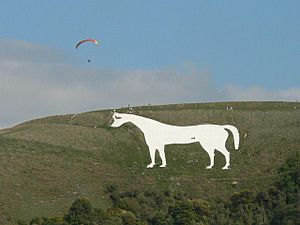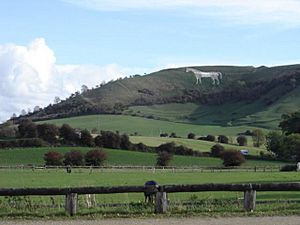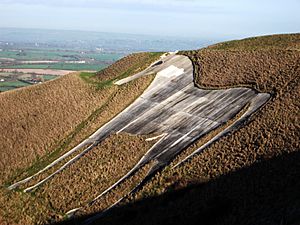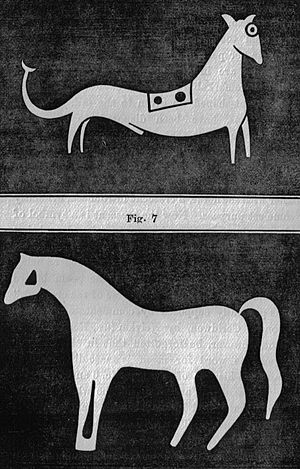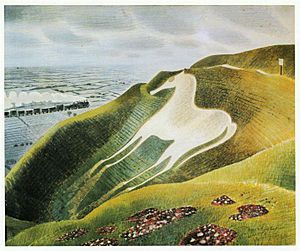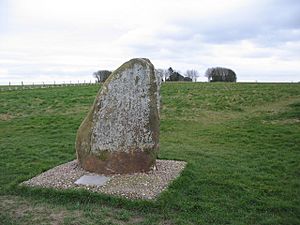Westbury White Horse facts for kids
The Westbury White Horse is a giant horse shape carved into a hillside in Wiltshire, England. It's about 1.5 miles east of the town of Westbury. You can find it on the edge of Bratton Downs, right below an ancient Iron Age hill fort. This horse is the oldest of many white horse figures found in Wiltshire.
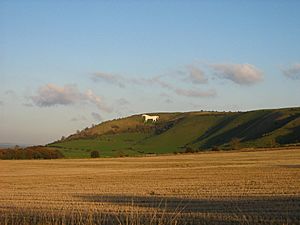
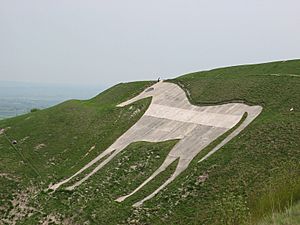
The horse was fixed up in 1778. Before that, there might have been a different, smaller horse facing the other way. We don't have any clear records of a chalk horse here before 1742.
The Westbury White Horse is 180 feet tall and 170 feet wide. It has become a special symbol for the town of Westbury. You can see it on welcome signs and on the logo for the local tourist center. Many people also see it as a symbol for all of Wiltshire.
Contents
The Horse's Beginnings
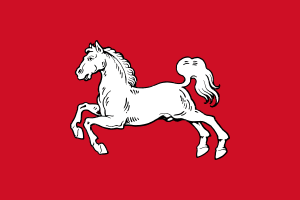
Even though it's the oldest white horse in Wiltshire, no one is completely sure how the Westbury White Horse started.
Many people think it was made to remember King Alfred's victory at the Battle of Ethandun in 878. This battle might have happened about 2 miles from the horse in a place called Edington. However, there's no proof of this story until the late 1700s.
Another famous chalk horse, the Uffington White Horse, is linked to King Alfred's early life. He was born near it in Oxfordshire. Unlike the Westbury horse, the Uffington horse has been mentioned in old documents since the 1000s. It's also much older, dating back to the Bronze Age.
Some historians believe the Westbury White Horse might have been carved in the early 1700s. This was when the new British Royal Family, the House of Hanover, came to power. The white horse was a symbol for them, so carving it could have shown loyalty to the new rulers.
A monk named Illtyd Trethowan wrote a book in 1939. He said there was no real link between the Westbury White Horse and King Alfred or the Battle of Ethandun. Another writer, Paul Newman, suggested in 2009 that the horse might have been inspired by popular "folly" buildings from the 1700s.
Local stories in Wiltshire say that when the church clock in nearby Bratton strikes midnight, the white horse goes down to the Bridewell Springs below the hill to drink.
Modern History of the Horse
By 1872, the horse's shape had changed because chalk kept growing over it. In 1873, a group of people reshaped it. They also added stones around its edges to help keep its shape.
The horse was lit up at night in 1900 and again in 1950 using army lights. In 1950, so many cars stopped to look that traffic almost completely stopped in Westbury and Bratton.
In the 1950s, the local council covered the horse with concrete. They hoped this would save money on keeping it clean. Over time, the concrete turned grey. It was cleaned in 1993.
In 2003, someone wrote "Stop This War" in yellow on the horse. This was a protest against the Iraq War. After the words were removed, the horse had a grey area with a white stripe where the message had been. In 2006, the horse was repainted, and the old damage was fixed. The newly whitened horse was lit up again with Second World War searchlights. In 2010, the word "wonkey" was written on its neck. This part had to be rewhitened, making the neck look whiter than the rest of the horse.
The horse was cleaned again in April 2012. This cleaning happened around the time of Queen Elizabeth II's Diamond Jubilee. After the work was done, the horse was lit up with searchlights once more. Since 2012, the horse has been lit up at night during the annual Trowbridge Village Pump Festival. A special spotlight changes colors, making the horse appear in different shades.
In 1999, two signs were put up near the horse. They show all eight Wiltshire White Horses. There's also a special stone structure from 1968 that points out towns and cities you can see from the hillside. For Queen Elizabeth II's Golden Jubilee in 2002, a fire beacon was placed near the car park. It is lit sometimes, like for the 70th anniversary of VE Day in 2015.
In June 2018, the BBC showed a video of volunteers cleaning the horse with high-pressure water jets. About 18 people helped, and the cleaning cost £3,000. The last time it was cleaned before that was in 2016.
Views of the Horse
You can see the Westbury White Horse from up to 16-17 miles away in all directions. From the horse itself, you can clearly see the towns of Westbury and Trowbridge. The Mendip TV Mast in Somerset is also visible to the west, especially at night. From the top of the horse and Bratton Castle, you can see the Devizes White Horse and the Alton Barnes White Horse. However, you cannot see the Westbury horse from other hill figures. Some of the furthest places it can be seen from are Beckford's Tower in Bath and the tower of St Michael's Church, Dundry near Bristol.
There is a car park on the B3098 road below the horse, called the Westbury White Horse Viewing Area. It has parking spaces and information boards about the horse.
In 1961, a 400-foot tall chimney was built at a cement factory about 1.5 miles from the horse. This chimney was taken down on September 18, 2016. Some people thought it was ugly, while others saw it as a local landmark. The chimney used to be a very noticeable part of the view from the horse.
In 2013, there were plans for a new road and business park near the horse. Some local people were worried this would spoil the area, but others felt Westbury needed a new road to help with traffic.
Battle of Ethandun Memorial
Even though the white horse is thought to remember King Alfred's victory, there is also an official monument to the Battle of Ethandun. It's on top of the hill, next to Bratton Camp. This monument is a large stone with a metal plaque. It was officially shown to the public on November 5, 2000.
King Alfred's Tower, near Stourhead, is another famous monument built to celebrate King Alfred's victory. This tower was built in 1772, six years before the Westbury White Horse was reshaped.


